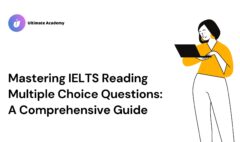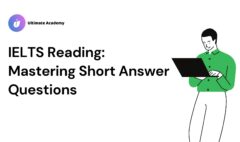How To Do Map Questions in IELTS Reading for 8+ Band
In the IELTS writing task 1, you will be asked to explain a map.
Although it is not common to get map questions, but they do appear, and you should learn how to describe a map.
It’s better to be prepared than regretting later.
You should be prepared for all types of questions to do better than most of the other students.
In this blog, I am going to share effective strategies to explain a map question in the right way.
Section 1
-
- Types of Map Questions
Section 2
-
- Describing Locations
Section 3
-
- Structure
Section 4
-
- Example
Section 1: Types of Map Questions
Map Questions are of three types:
- One Map Question: You will be given one map in the present day. It is a very rare type and you will use the present simple tense and no comparisons can be made.
- Two-Map Question (Present-Future): You will be provided with two maps where one map will be of present-day and the other one will show the future. You will use both present and future tenses. You will have to explain the possible future developments in the town or city.
- Two-Map Question (Present-Past): You will be provided with two maps, one in the past and one in the present day. It is the most common type. You will select and describe the main features, and make comparisons where relevant. You will use both present and past tenses to explain the changes that have occurred over time.
Section 2: Describing Locations
In map questions, you will have to write about the location of things on maps and explain where developments have taken place.
You should write the terminology specific to this type of question.
Always describe the location of things by using the words ‘center’, ‘north’, ‘south’, ‘east’ and ‘west’.
For example:
- The airport was constructed to the south of the city.
- The building in the center of the city was demolished.
You need to use prepositions of place to explain the locality of things.
Prepositions that will be used are: At, by, beside, to, from, in, and, to, etc.
Examples include:
- Dramatic improvements have occurred in the city.
- A new swimming pool was built next to the school.
Section 3: Structure
You should always follow a 5-paragraph structure. One introductory paragraph, 3 body paragraphs, and one ending paragraph.
First Paragraph: Paraphrase the Question given
In the 1st Paragraph, you simply have to paraphrase the given question by using synonyms.
As the use of terminology differs with the type of question being presented so in this case you have to use synonyms specific for Map questions.
1st paragraph comprises of one sentence.
2nd Paragraph: Overview
In the 2nd paragraph, you have to write an overview of the important features of the maps.
In the overview, you will write generally about the most striking differences between the two maps.
Pick two or three of the most noticeable differences in the maps and write a general statement for each.
In order to recognize general changes you should look for following the information:
- Maps are residential or nonresidential.
- Maps are of Countryside or urban area.
- Changes are considerable or insignificant.
- Major developments in infrastructure.
- Changes in the buildings.
Below are some examples of how you can write generally about changes that are shown in maps:
- From 2005 to 2015, the city center witnessed dramatic improvements.
- Over the past 10 years, the residential area was rebuilt.
- Over the period of time, old docks changed considerably.
- From 2010 to 2015, the village changed dramatically.
3rd Paragraph: Detailed Analysis of changes
In this Paragraph, you will be more particular about specific changes that have occurred.
You have to write a brief descriptive paragraph of three to four sentences about specific changes that have occurred over the period of time.
Below is the list of verbs, you can use to describe specific changes, with some examples.
For describing changes in buildings: you can use the following verbs to describe changes that have taken place in buildings:
- Demolished, replaced, rebuilt, and developed, constructed, relocated, converted, extended, and modernized.
Example:
- The government demolished the residential area and constructed a shopping mall.
For describing changes in forests or trees: you can use the following verbs to describe changes that have taken place in forests or trees.
- cleared, cut-down, and removed.
Example:
- The trees were cut down to make way for houses.
4th Paragraph: Detailed Analysis of changes
In the 4th paragraph, describe remaining distinct changes between two maps in three to four sentences just as you did in 3rd paragraph.
Below is the list of verbs, you can use to describe specific changes, with some examples.
For describing changes in infrastructure:
- Constructed, built, extended, expanded, and removed.
Example:
- The main road was extended and a new bridge built over the river.
For describing changes in Leisure facilities:
- Opened up, set up, and developed.
Example:
- A park was set up next to the school.
5th Paragraph: Summary
The summary is not much of the significance.
It’s not compulsory and only comprises one sentence where you summarize the whole essay.
It’s just like the paraphrasing of the question.
Section 4: Example
The two maps below show an island, before and after the construction of some tourist facilities.

Answer
Both maps display an island, before and after it was developed for tourism.
The island is approximately 250 meters long, has palm trees dotted around it, is surrounded by ocean, and has a beach to the west. Over the period, the island was completely transformed with the addition of a hotel and a pier; however, the eastern part of the island appears to have been left undeveloped.
The most noticeable additions are the hotel rooms. 6 buildings, surrounding some trees, have been built in the west of the island and 9 buildings have been constructed in the center of the island. Between the two accommodation areas, a reception building and a restaurant have been developed.
A pier has also been built on the south coast of the island, allowing yachts access to the resort. Apart from the trees, the beach remains the only natural feature to remain relatively untouched; however, it does appear that it is now used for swimming.
—————————————
In this blog post, I have mentioned a strategy for explaining map question to ace your IELTS Writing Task 1.
In my full course, Ultimate Guide to Hacking IELTS, I go deep into the strategies, hacks, and techniques to help you learn all 4 sections of IELTS in smart way to get 8+ Band.
You can access the course here:







